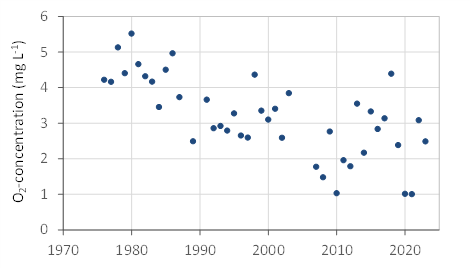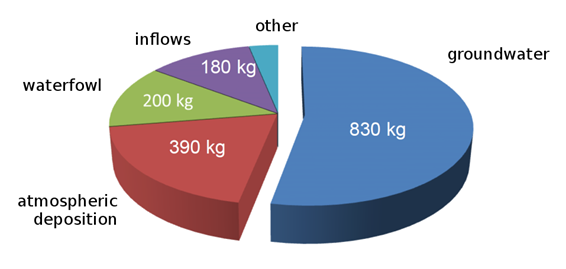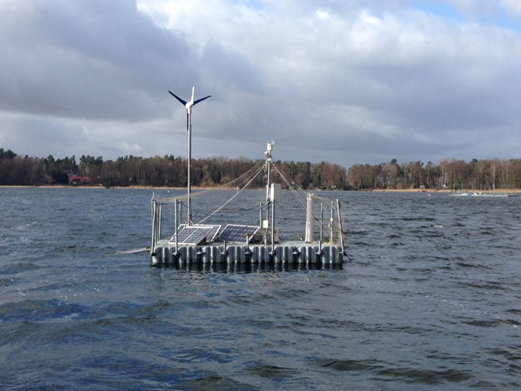Lake Arendsee in the Altmark region of northern Saxony-Anhalt is located in a traditional touristic and recreational area. With an area of over five square kilometers, the lake is about twice the size of Lake Wannsee in Berlin. It is the deepest natural lake in Saxony-Anhalt with a maximal depth of up to 49 metres and one of the deepest lakes in northern Germany. The lake attracts visitors for swimming, sailing and diving. The town of Arendsee on the southern side of the lake is a climatic health resort. Due to its particularly good water quality until the middle of the last century and certainly also because of its relatively round shape, it is known as the "Pearl of the Altmark".
Characteristics
Area: 5.14 km ²
Maximum depth: 48 m
Average depth: 29 m
Water volume: 147 million m³
Maximum length: 3.24 km
Maximum width: 2 km

Depth map of lake Arendsee. Source: Landesbetrieb für Hochwasserschutz und Wasserwirtschaft Sachsen-Anhalt, 2009.
State of the lake
The ecological state of Lake Arendsee was assessed as “poor” in the 2009-2013 surveys for the implementation of the European Water Framework Directive (EU WFD, German: Wasserrahmenrichtlinie EU-WRRL). Lakes are essentially categorised according to their trophic situation, which describes the nutrient load and the reaction of phytoplankton to this nutrient supply.
Lake Arendsee is a highly eutrophic, which means nutrient-rich, lake. Due to the high nutrient concentrations, especially of phosphorus (P), microalgae and cyanobacteria (blue-green algae) find optimal growth conditions. Both are a natural part of the biotic community in our lakes, but they can increase extremely if there is an oversupply of nutrients. Cyanobacteria can produce toxic substances (cyanotoxins), which pose a health risk if they develop en masse. For this reason, there have been several restrictions on swimming at Lake Arendsee in the past. The intense green colour of the water and the formation of unsightly algae carpets on the water surface can also deter visitors. In addition to the periodical mass development of cyanobacteria, other signs of severe eutrophication include low water transparency during summer, a lack of oxygen in the deep water and the disappearance of the original underwater vegetation. The cause of the undesirable eutrophication is the high concentration of the nutrient phosphorus in the water body of Lake Arendsee, which has been too high for many years. It has been over 170 µg P L-1 for the last 20 years.

Phosphorus development in Lake Arendsee. The graph shows the annual mean concentration of the total phosphorus.
In recent decades, changes in the oxygen balance of the lake have been recorded. The amount of oxygen remaining in the deep water below 20 m in autumn has decreased significantly since 1976. A large part of the hypolimnion is oxygen-free at the end of the stratification. The main reason of this low oxygen concentration is the increased primary production in the upper water body due to excessive nutrient concentrations. After dying, the algae sink to the bottom and are degraded by microorganisms while consuming oxygen.

Oxygen in the deep water of Lake Arendsee. The figure shows the average oxygen concentration on 1st of November of each year in the layer between 20 and 48 m from 1976 onwards. The average oxygen concentration towards the end of the summer stratification has decreased by about 50% during this period.
Origin of the phosphorus load
Extensive research in recent years on the sources of the high phosphorus concentrations has shown that more than half of the phosphorus enters the lake through the groundwater. Groundwater analyses in the catchment area have shown that particularly high phosphorus concentrations (up to 5000 µg L-1) were found in the area of the town of Arendsee, particularly in the shore section between Kloster and Bleiche. A natural P concentration of 10-20 µg L-1 would be expected in the groundwater.
As the P concentrations in the groundwater in the surrounding agricultural areas are quite low, a P input from agriculture via liquid manure or mineral fertiliser can probably be excluded. It is unlikely that the phosphorus in the groundwater originates from a single contaminated site, as a broad wastewater plume would then be expected downstream. Instead, many well water samples provided by residents of the city of Arendsee as part of measurement campaigns in 2012 and 2022 have shown that there must be many single point sources in the urban area. High and low phosphorus concentrations are found in close proximity to each other. The causes of the pollution have not yet been identified. Possible sources of phosphorus in groundwater are improperly removed septic tanks, fertilisation in private gardens and leaking sewage systems.
The second largest source of input is atmospheric pollution. Surface inflows and the wintering of northern geese also contribute to the high phosphorus concentration in the lake.

Phosphorus inputs into Lake Arendsee: The lake receives about 1.6 tons of phosphorus annually. The main part comes from the groundwater. The natural load via the groundwater would only be about 70 kg per year.
Possible measures to improve water quality
Previous attempts of restoration measures did not have the desired effect. In 1976, a deepwater withdrawal was installed, which removes P rich water from the deeper water layers of the lake. In this way it was expected that large amounts of P could be removed from the lake but these expectations were not fulfilled. To reduce the phosphorus content significantly, water abstraction would have had to be increased to such an extent that the water level would have been lowered. Covering the sediment with calcareous mud from the shallower part of the lake in 1995 did not lead to any noticeable improvement, either. This measure was intended to prevent P release from the sediment. However, it turned out that the P present in the water and the constant supply from outside are decisive for the state of the lake.
In several studies commissioned by the State Office for Flood Protection and Water Management (Landesbetrieb für Hochwasserschutz und Wasserwirtschaft, Saxony-Anhalt), the lake, its catchment area and its inflows were comprehensively investigated in order to develop a concept for the restoration of the lake. The proposed lake-internal phosphorus precipitation is expected to result in an immediate reduction of phosphorus in the water body. The chances of success of this measure are good due to the long water renewal period of around 50 years. However, if the external load persists, the long-term effectiveness of P precipitation is limited. The ideal solution would be to combine precipitation (immediate effect) with simultaneous or delayed measures to reduce the external load (ensuring sustainability). Without additional measures, Lake Arendsee will not be able to achieve the required good ecological status in accordance with the requirements of the EC WFD.
Research at Lake Arendsee
There are only a few lakes in Germany that have been studied as well as Lake Arendsee in recent decades in terms of the parameter spectrum and the spatial and temporal resolution of measurements. The first investigations were made by Prof. Wilhelm Halbfaß in 1896. Continuous data series have been available since the mid-1970s.
The IGB has been operating a measuring platform on the lake since 2010. Here we collect weather data and measure various water parameters using multi-parameter probes. The data are transmitted online and can be found online under https://emon.igb-berlin.de/arendsee.html. The meteorological data and the readings from a probe at the surface of the water are recorded at ten-minute intervals. In addition, four vertical profiles of the most important water parameters such as temperature, oxygen, pH value, conductivity and chlorophyll are recorded every day at intervals of 1 metre. The monitoring programme includes additional water sampling for chemical and biological analyses. These are taken monthly in winter and fortnightly in summer, alternating with the State Office for Flood Protection and Water Management (LHW). Extensive groundwater analyses are carried out twice a year and the sediment is analysed at regular intervals. The Oxygen development in the water body is monitored using a measuring chain with oxygen loggers attached.
Long-term monitoring of lakes is an essential tool for understanding the complex effects of environmental changes. The investigations at Lake Arendsee are part of a Germany-wide monitoring programme for lakes to record the effects of global warming. The data obtained is also used to develop models for forecasting, on the basis of which management measures can be derived.


Sketch of a measuring chain and measuring station at Lake Arendsee.

